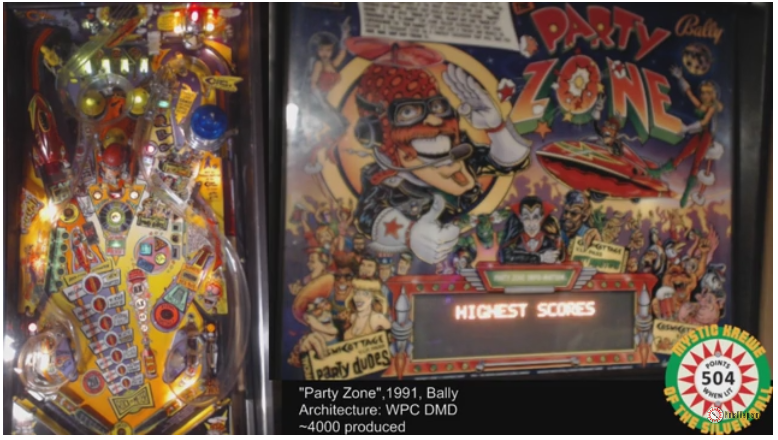A very common source for pinball machines is from storage lockers. And when you help someone clean out a storage locker, you never know what other kinds of deals there might be. This is the story of getting a pinball machine and something else (that makes a pinball machine seem puny).
Tag Archives: pz
“Party Zone” – Pinball Showcase and Review

I just pulled this game off route and decided to do a showcase video, so enjoy this quick overview and introduction to this really neat, rare, early WPC DMD game, “Party Zone” by Bally.
1991 Bally early WPC DMD game by Dennis Nordman with art by Greg Freres. Review and play overview and game introduction. This game also plays “Pinball Wizard” by the Who. It has lots of humor, is a non-licensed theme featuring a variety of characters from other pinball machines including Elvira and the Party Monsters, Dr. Dude, Monster Bash and others. Features cool 80s music and 2-ball multi-ball.
Basic Rules:
Start multi-ball and build jackpot. Special song plays if you hit the max jackpot (Purple Haze by Jimi Hendrix). Visit the club three times to qualify multi-ball (shoot the right orbit-like shot, which isn’t an orbit but deposits the ball in a kick-out to the right ramp). During multi-ball shoot left orbit or right orbit shots to build the “rock-it fuel” jackpot, then the left ramp to collect. There is no ball save.
Various interesting features including, Captain B-Zarr – an amusing comical DJ that will play different songs you can select by hitting the center saucer after qualifying by hitting the two targets flanking the saucer.
Supersonic Robotic Comic: Random award qualified by hitting the three stand up targets to the right of this saucer, which kicks to the right ramp feeding the right flipper (same kickout the club shot goes do). The robot talks backwards in random gibberish and awards things like multi-ball, laugh attack (all switches score extra points), random points, and bop-till-you-drop where the pop bumpers score 1m each and punk music plays.
Eat, Drink, Be Merry: Shoot green stand up targets on the left to qualify, then shoot the left ramp for Eat (1m), then the right saucer (Supersonic Robotic Comic) for 2m, then the center saucer for “Be Merry” for 3m – amusing animations.
Way Out Of Control: Shoot the lower right stand up targets to qualify, each time enables a different mode for the far right shot (5m, 10x playfield, special, etc.) – when not qualified shoot this shot for 1m and more each shot.
End Zone: Outlanes when lit, reward points; more points by hitting the football player targets
Review:
Great game with great flow and a fun, unique theme. Beautiful artwork. Ruleset is simple yet challenging. A great game to practice pinball technique including nudging. Reliable game on location, lots of playability in home use as well. Short ball times with lots of repeat playability. Great game for competitive pinball.
Gameplay: 8 – Fun, challenging game with a lot of repeat playability; a bit difficult/unforgiving for beginner players.
Playfield Design: 8 – Excellent flow and satisfying shots; cool and unique ramps; looks more simple than it is.
Ruleset: 7 – Shallow but fun ruleset that gets players shooting all over the playfield; a few modes stack with each other allowing strategic play for higher caliber players. But otherwise a short list of modes and features that interrupt each other. Scoring is well-balanced.
Art: 7 – Gorgeous day-glow art package that is fun and frivolous. People are likely to either love or hate the art, not because of the talent or quality but depending upon whether they appreciate the offbeat theme.
Music: 7 – Another hit-or-miss. If you can appreciate the intentionally kitschy 80s-style adaptations of popular songs which fit in with the theme, you’ll enjoy this.
Theme: 7 – Unique, non-licensed theme.
Creativity: 7 – Overall a very creative pinball machine that takes more chances with art and theme than playfield or mechanics.
This is an unedited series of videos showcasing some experiments I have been doing trying to repair damaged pinball ramps for which there are no replacements available at the present time. In this case, I’m working on a Bally Party Zone ramp, using different types of epoxies, plastics and adhesives. See work works and what doesn’t. In the end, I figured a creative approach using laser cut plexiglass tabs which were attached to ramps using two different types of adhesives.
